Bhutan
Bhutan (/buːˈtɑːn/ (![]()
Kingdom of Bhutan
| |
|---|---|
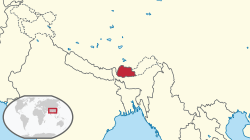 | |
| Capital and largest city | Thimphu 27°28.0′N 89°38.5′E |
| Official languages | Dzongkha |
| Religion | 74.8% Vajrayana Buddhism (official) 22.6% Hinduism 1.9% Bon and other indigenous faith 0.5% Christianity 0.4% Islam 0.2% Other |
| Demonym(s) | Bhutanese |
| Government | Unitary parliamentary constitutional monarchy |
• Druk Gyalpo (monarch) | Jigme Khesar Namgyel Wangchuck |
• Prime Minister | Lotay Tshering |
| Legislature | Parliament |
| National Council | |
| National Assembly | |
| Formation | |
• Unification of Bhutan | 1616–1634 |
| 17 December 1907 | |
• Indo-Bhutan Treaty | 8 August 1949 |
| 21 September 1971 | |
| 18 July 2008 | |
| Area | |
• Total | 38,394 km2 (14,824 sq mi)[1][2] (133rd) |
• Water (%) | 1.1 |
| Population | |
• 2018 estimate | 754,388[3][4] (165th) |
• 2017a census | 727,145[5] |
• Density | 19.3/km2 (50.0/sq mi) (162nd) |
| GDP (PPP) | 2018 estimate |
• Total | $7.701 billion[6] |
• Per capita | $9,426[6] (115th) |
| GDP (nominal) | 2018 estimate |
• Total | $2.547 billion[6] |
• Per capita | $3,117[6] (130th) |
| Gini (2017) | 37.4[7] medium |
| HDI (2018) | medium · 134th |
| Currency | Ngultrum (BTN) |
| Time zone | UTC+06 (BTT) |
| Driving side | left |
| Calling code | +975 |
| ISO 3166 code | BT |
| Internet TLD | .bt |
| |
Bhutan's independence has endured for centuries. It has never been colonized in its history. Situated on the ancient Silk Road between Tibet, the Indian subcontinent and Southeast Asia, the Bhutanese state developed a distinct national identity based on Buddhism. Headed by a spiritual leader known as the Zhabdrung Rinpoche, the territory comprised many fiefdoms and was governed as a Buddhist theocracy. Following a civil war in the 19th century, the House of Wangchuck reunited the country and established relations with the British Empire. After the end of the British Raj, Bhutan fostered a strategic partnership with India during the rise of Chinese communism; it has a disputed border with China. In the early 1990s, the government deported much of the country's Nepali-speaking Lhotsampa minority, sparking a refugee crisis in nearby Jhapa, Nepal. In 2008, Bhutan transitioned from an absolute monarchy to a constitutional monarchy and held the first election to the National Assembly of Bhutan. The National Assembly is part of the bicameral parliament of the Bhutanese democracy.[12]
The country's landscape ranges from lush subtropical plains in the south to the sub-alpine Himalayan mountains in the north, where there are peaks higher than 7,000 metres (23,000 ft). Gangkhar Puensum is Bhutan's highest peak and may also be the highest unclimbed mountain in the world.[13] The wildlife of Bhutan is notable for its diversity.
In South Asia, Bhutan ranks first in economic freedom, ease of doing business and peace and is the least corrupt country in the region as of 2016. It continues to be a least developed country, but expects to graduate from this status by 2023. Hydroelectricity accounts for most of its exports.[14] The government is a parliamentary democracy; the head of state is the King of Bhutan, known as the "Dragon King." Bhutan maintains diplomatic relations with 52 countries and the European Union, but does not have formal ties with the five permanent members of the United Nations Security Council. It is a member of the United Nations, SAARC, BIMSTEC and the Non-Aligned Movement. The Royal Bhutan Army maintains a close relationship with the Indian Armed Forces and Bangladesh Armed Forces.
Bhutan is also notable for pioneering the concept of Gross National Happiness.[15]
Etymology
The precise etymology of "Bhutan" is unknown, although it is likely to derive from the Tibetan endonym "Böd" for Tibet. Traditionally, it is taken to be a transcription of the Sanskrit Bhoṭa-anta "end of Tibet", a reference to Bhutan's position as the southern extremity of the Tibetan plateau and culture.[16][17][18]
Since the 17th century Bhutan's official name has been Druk yul (country of the Drukpa Lineage, the Dragon People, or the Land of the Thunder Dragon, a reference to the country's dominant Buddhist sect); "Bhutan" appears only in English-language official correspondence.[18]
Names similar to Bhutan—including Bohtan, Buhtan, Bottanthis, Bottan and Bottanter—began to appear in Europe around the 1580s. Jean-Baptiste Tavernier's 1676 Six Voyages is the first to record the name Boutan. But these names seem to have referred not to modern Bhutan but to the Kingdom of Tibet. The modern distinction between the two did not begin until well into the Scottish explorer George Bogle's 1774 expedition. Realizing the differences between the two regions, cultures and states, his final report to the East India Company formally proposed calling the Druk Desi's kingdom "Boutan" and the Panchen Lama's "Tibet". The EIC's surveyor general James Rennell first anglicized the French name as Bootan and then popularized the distinction between it and greater Tibet.[19]
Locally, Bhutan has been known by many names. One of the earliest Western records of Bhutan, the 1627 Relação of the Portuguese Jesuits Estêvão Cacella and João Cabral, records its name variously as Cambirasi (among the Koch Biharis[20]), Potente, and Mon (an endonym for southern Tibet).[19] The first time a separate Kingdom of Bhutan appeared on a western map, it did so under its local name "Broukpa".[19] Others include Lho Mon ("Dark Southland"), Lho Tsendenjong ("Southland of the Cypress"), Lhomen Khazhi ("Southland of the Four Approaches") and Lho Menjong ("Southland of the Herbs").[21][22]
History
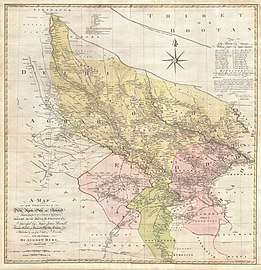

Stone tools, weapons, elephants, and remnants of large stone structures provide evidence that Bhutan was inhabited as early as 2000 BC, although there are no existing records from that time. Historians have theorized that the state of Lhomon (literally, "southern darkness"), or Monyul ("Dark Land", a reference to the Monpa, the aboriginal peoples of Bhutan) may have existed between 500 BC and AD 600. The names Lhomon Tsendenjong (Sandalwood Country), and Lhomon Khashi, or Southern Mon (country of four approaches), have been found in ancient Bhutanese and Tibetan chronicles.[23][24]
.jpg)
Buddhism was first introduced to Bhutan in the 7th century AD. Tibetan king Songtsän Gampo[25] (reigned 627–649), a convert to Buddhism, who actually had extended the Tibetan Empire into Sikkim and Bhutan,[26] ordered the construction of two Buddhist temples, at Bumthang in central Bhutan and at Kyichu (near Paro) in the Paro Valley.[27] Buddhism was propagated in earnest[25] in 746[28] under King Sindhu Rāja (also Künjom;[29] Sendha Gyab; Chakhar Gyalpo), an exiled Indian king who had established a government in Bumthang at Chakhar Gutho Palace.[30]:35[31]:13
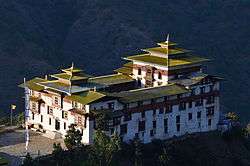
Much of early Bhutanese history is unclear because most of the records were destroyed when fire ravaged the ancient capital, Punakha, in 1827. By the 10th century, Bhutan's political development was heavily influenced by its religious history. Various subsects of Buddhism emerged that were patronized by the various Mongol warlords.
Bhutan may have been influenced by the Yuan dynasty with which it shares various cultural and religious similarities.
After the decline of the Yuan dynasty in the 14th century, these subsects vied with each other for supremacy in the political and religious landscape, eventually leading to the ascendancy of the Drukpa Lineage by the 16th century.[27][32]
Until the early 17th century, Bhutan existed as a patchwork of minor warring fiefdoms, when the area was unified by the Tibetan lama and military leader Ngawang Namgyal, who had fled religious persecution in Tibet. To defend the country against intermittent Tibetan forays, Namgyal built a network of impregnable dzongs or fortresses, and promulgated the Tsa Yig, a code of law that helped to bring local lords under centralized control. Many such dzong still exist and are active centers of religion and district administration. Portuguese Jesuits Estêvão Cacella and João Cabral were the first recorded Europeans to visit Bhutan in 1627,[33] on their way to Tibet. They met Zhabdrung Ngawang Namgyal, presented him with firearms, gunpowder and a telescope, and offered him their services in the war against Tibet, but the Zhabdrung declined the offer. After a stay of nearly eight months Cacella wrote a long letter from the Chagri Monastery reporting on his travels. This is a rare extant report of the Zhabdrung.[34][35]
When Ngawang Namgyal died in 1651, his passing was kept secret for 54 years. After a period of consolidation, Bhutan lapsed into internal conflict. In 1711 Bhutan went to war against the Raja of the kingdom of Koch Bihar in the south. During the chaos that followed, the Tibetans unsuccessfully attacked Bhutan in 1714.[36]
In the 18th century, the Bhutanese invaded and occupied the kingdom of Koch Bihar. In 1772, the Maharaja of Koch Bihar appealed to the British East India Company which assisted by ousting the Bhutanese and later in attacking Bhutan itself in 1774. A peace treaty was signed in which Bhutan agreed to retreat to its pre-1730 borders. However, the peace was tenuous, and border skirmishes with the British were to continue for the next hundred years. The skirmishes eventually led to the Duar War (1864–65), a confrontation for control of the Bengal Duars. After Bhutan lost the war, the Treaty of Sinchula was signed between British India and Bhutan. As part of the war reparations, the Duars were ceded to the United Kingdom in exchange for a rent of Rs. 50,000. The treaty ended all hostilities between British India and Bhutan.
During the 1870s, power struggles between the rival valleys of Paro and Tongsa led to civil war in Bhutan, eventually leading to the ascendancy of Ugyen Wangchuck, the penlop (governor) of Trongsa. From his power base in central Bhutan, Ugyen Wangchuck defeated his political enemies and united the country following several civil wars and rebellions during 1882–85.[37]
In 1907, an epochal year for the country, Ugyen Wangchuck was unanimously chosen as the hereditary king of the country by the Lhengye Tshog of leading Buddhist monks, government officials, and heads of important families, with the firm petition made by Gongzim Ugyen Dorji. John Claude White, British Political Agent in Bhutan, took photographs of the ceremony.[38] The British government promptly recognized the new monarchy, and in 1910 Bhutan signed the Treaty of Punakha, a subsidiary alliance which gave the British control of Bhutan's foreign affairs and meant that Bhutan was treated as an Indian princely state. This had little real effect, given Bhutan's historical reticence, and also did not appear to affect Bhutan's traditional relations with Tibet. After the new Union of India gained independence from the United Kingdom on 15 August 1947, Bhutan became one of the first countries to recognize India's independence. On 8 August 1949, a treaty similar to that of 1910, in which Britain had gained power over Bhutan's foreign relations, was signed with the newly independent India.[23]
In 1953, King Jigme Dorji Wangchuck established the country's legislature – a 130-member National Assembly – to promote a more democratic form of governance. In 1965, he set up a Royal Advisory Council, and in 1968 he formed a Cabinet. In 1971, Bhutan was admitted to the United Nations, having held observer status for three years. In July 1972, Jigme Singye Wangchuck ascended to the throne at the age of sixteen after the death of his father, Dorji Wangchuck.
In the 1990s, Bhutan expelled most of its ethnic Lhotshampa population, one-fifth of the country's population, demanding conformity in religion, dress, and language.[39][40][41] Most of the Bhutanese refugees emigrated to eastern Nepal, where they lived in refugee camps for over a decade.[41] Since 2008, many Western countries, such as Canada, Norway, the UK, Australia, and the US, have begun accepting the refugees.[42]
Political reform and modernization
Bhutan's political system has recently changed from an absolute monarchy to a constitutional monarchy. King Jigme Singye Wangchuck transferred most of his administrative powers to the Council of Cabinet Ministers and allowed for impeachment of the King by a two-thirds majority of the National Assembly.[43]
In 1999, the government lifted a ban on television and the Internet, making Bhutan one of the last countries to introduce television. In his speech, the King said that television was a critical step to the modernization of Bhutan as well as a major contributor to the country's gross national happiness,[44] but warned that the "misuse" of this new technology could erode traditional Bhutanese values.[45]
A new constitution was presented in early 2005. In December 2005, Wangchuck announced that he would abdicate the throne in his son's favour in 2008. On 14 December 2006, he announced that he would be abdicating immediately. This was followed by the first national parliamentary elections in December 2007 and March 2008.
On 6 November 2008, 28-year-old Jigme Khesar Namgyel Wangchuck was crowned king.[46]
Geography
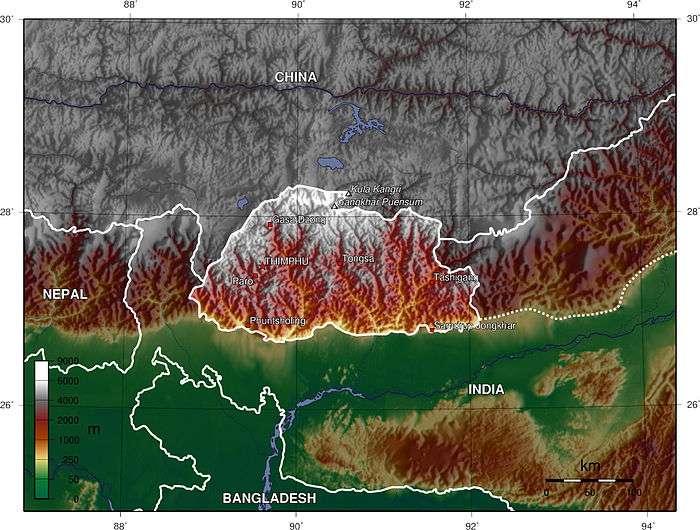
Bhutan is on the southern slopes of the eastern Himalayas, landlocked between the Tibet Autonomous Region of China to the north and the Indian states of Sikkim, West Bengal, Assam to west and south and the Indian state of Arunachal Pradesh to the east. It lies between latitudes 26°N and 29°N, and longitudes 88°E and 93°E. The land consists mostly of steep and high mountains crisscrossed by a network of swift rivers that form deep valleys before draining into the Indian plains. Elevation rises from 200 m (660 ft) in the southern foothills to more than 7,000 m (23,000 ft). This great geographical diversity combined with equally diverse climate conditions contributes to Bhutan's outstanding range of biodiversity and ecosystems.[2]
Bhutan's northern region consists of an arc of Eastern Himalayan alpine shrub and meadows reaching up to glaciated mountain peaks with an extremely cold climate at the highest elevations. Most peaks in the north are over 7,000 m (23,000 ft) above sea level; the highest point is Gangkhar Puensum, at 7,570 metres (24,840 ft), which has the distinction of being the highest unclimbed mountain in the world.[47] The lowest point, at 98 m (322 ft), is in the valley of Drangme Chhu, where the river crosses the border with India.[47] Watered by snow-fed rivers, alpine valleys in this region provide pasture for livestock, tended by a sparse population of migratory shepherds.
The Black Mountains in Bhutan's central region form a watershed between two major river systems: the Mo Chhu and the Drangme Chhu. Peaks in the Black Mountains range between 1,500 and 4,925 m (4,921 and 16,158 ft) above sea level, and fast-flowing rivers have carved out deep gorges in the lower mountain areas. The forests of the central Bhutan mountains consist of Eastern Himalayan subalpine conifer forests in higher elevations and Eastern Himalayan broadleaf forests in lower elevations. Woodlands of the central region provide most of Bhutan's forest production. The Torsa, Raidak, Sankosh, and Manas are Bhutan's main rivers, flowing through this region. Most of the population lives in the central highlands.
In the south, the Shiwalik Hills are covered with dense Himalayan subtropical broadleaf forests, alluvial lowland river valleys, and mountains up to around 1,500 m (4,900 ft) above sea level. The foothills descend into the subtropical Duars Plain. Most of the Duars is in India, but a 10 to 15 km (6.2 to 9.3 mi)-wide strip extends into Bhutan. The Bhutan Duars is divided into two parts, the northern and southern Duars.
The northern Duars, which abut the Himalayan foothills, have rugged, sloping terrain and dry, porous soil with dense vegetation and abundant wildlife. The southern Duars has moderately fertile soil, heavy savanna grass, dense, mixed jungle, and freshwater springs. Mountain rivers, fed by melting snow or monsoon rains, empty into the Brahmaputra River in India. Data released by the Ministry of Agriculture showed that the country had a forest cover of 64% as of October 2005.
- Landscape of Bhutan
_(4677022812).jpg) Gangkar Puensum, the highest mountain in Bhutan
Gangkar Puensum, the highest mountain in Bhutan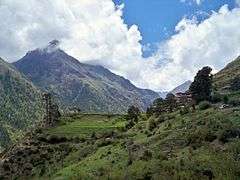 Sub-alpine Himalayan landscape
Sub-alpine Himalayan landscape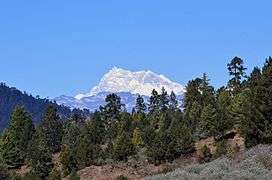 A Himalayan peak from Bumthang
A Himalayan peak from Bumthang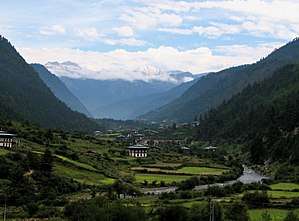 The Haa Valley in Western Bhutan
The Haa Valley in Western Bhutan
Climate
Bhutan's climate varies with elevation, from subtropical in the south to temperate in the highlands and polar-type climate with year-round snow in the north. Bhutan experiences five distinct seasons: summer, monsoon, autumn, winter and spring. Western Bhutan has the heavier monsoon rains; southern Bhutan has hot humid summers and cool winters; central and eastern Bhutan are temperate and drier than the west with warm summers and cool winters.
Biodiversity
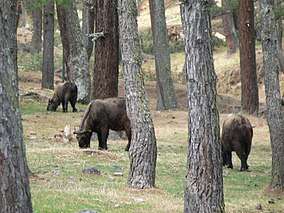
Bhutan signed the Rio Convention on Biological Diversity on 11 June 1992, and became a party to the convention on 25 August 1995.[48] It has subsequently produced a National Biodiversity Strategy and Action Plan, with two revisions, the most recent of which was received by the convention on 4 February 2010.[49]
Animals
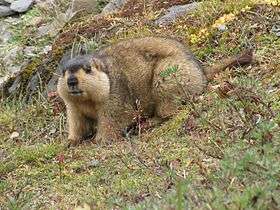
Bhutan has a rich primate life, with rare species such as the golden langur.[50][51] A variant Assamese macaque has also been recorded, which is regarded by some authorities as a new species, Macaca munzala.[52]
The Bengal tiger, clouded leopard, hispid hare and the sloth bear live in the tropical lowland and hardwood forests in the south. In the temperate zone, grey langur, tiger, goral and serow are found in mixed conifer, broadleaf and pine forests. Fruit-bearing trees and bamboo provide habitat for the Himalayan black bear, red panda, squirrel, sambar, wild pig and barking deer. The alpine habitats of the great Himalayan range in the north are home to the snow leopard, blue sheep, marmot, Tibetan wolf, antelope, Himalayan musk deer and the takin, Bhutan's national animal. The endangered wild water buffalo occurs in southern Bhutan, although in small numbers.[53]
More than 770 species of bird have been recorded in Bhutan. The globally endangered white-winged duck has been added recently to Bhutan's bird list.[54]
Plants
More than 5,400 species of plants are found in Bhutan,[55] including Pedicularis cacuminidenta. Fungi form a key part of Bhutanese ecosystems, with mycorrhizal species providing forest trees with mineral nutrients necessary for growth, and with wood decay and litter decomposing species playing an important role in natural recycling.
Conservation
The Eastern Himalayas have been identified as a global biodiversity hotspot and counted among the 234 globally outstanding ecoregions of the world in a comprehensive analysis of global biodiversity undertaken by WWF between 1995 and 1997.
According to the Swiss-based International Union for Conservation of Nature, Bhutan is viewed as a model for proactive conservation initiatives. The Kingdom has received international acclaim for its commitment to the maintenance of its biodiversity.[56] This is reflected in the decision to maintain at least sixty percent of the land area under forest cover, to designate more than 40%[57][58] of its territory as national parks, reserves and other protected areas, and most recently to identify a further nine percent of land area as biodiversity corridors linking the protected areas. All of Bhutan's protected land is connected to one another through a vast network of biological corridors, allowing animals to migrate freely throughout the country.[59] Environmental conservation has been placed at the core of the nation's development strategy, the middle path. It is not treated as a sector but rather as a set of concerns that must be mainstreamed in Bhutan's overall approach to development planning and to be buttressed by the force of law. The country's constitution mentions environment standards in multiple sections.[60]
Environmental issues
Although Bhutan's natural heritage is still largely intact, the government has said that it cannot be taken for granted and that conservation of the natural environment must be considered one of the challenges that will need to be addressed in the years ahead.[61] Nearly 56.3% of all Bhutanese are involved with agriculture, forestry or conservation.[60] The government aims to promote conservation as part of its plan to target Gross National Happiness. It currently has net negative[59] greenhouse gas emissions because the small amount of pollution it creates is absorbed by the forests that cover most of the country.[62] While the entire country collectively produces 2.2 million tons of carbon dioxide a year, the immense forest covering 72% of the country acts as a carbon sink, absorbing more than four million tons of carbon dioxide every year.[59]
Bhutan has a number of progressive environmental policies that have caused the head of the UNFCCC to call it an "inspiration and role model for the world on how economies and different countries can address climate change while at the same time improving the life of the citizen."[63] For example, electric cars have been pushed in the country and as of 2014 make up a tenth of all cars. Because the country gets most of its energy from hydroelectric power, it does not emit significant greenhouse gases for energy production.[62]
Pressures on the natural environment are already evident and will be fuelled by a complex array of forces. They include population pressures, agricultural modernization, poaching, hydro-power development, mineral extraction, industrialization, urbanization, sewage and waste disposal, tourism, competition for available land, road construction and the provision of other physical infrastructure associated with social and economic development.[64]
In practice, the overlap of these extensive protected lands with populated areas has led to mutual habitat encroachment. Protected wildlife has entered agricultural areas, trampling crops and killing livestock. In response, Bhutan has implemented an insurance scheme, begun constructing solar powered alarm fences, watch towers, and search lights, and has provided fodder and salt licks outside human settlement areas to encourage animals to stay away.[65]
The huge market value of the Ophiocordyceps sinensis fungus crop collected from the wild has also resulted in unsustainable exploitation which is proving very difficult to regulate.[66]
Bhutan has enforced a plastic ban rule from 1 April 2019, where plastic bags were replaced by alternative bags made of jute and other biodegradable material.[67]
Government and politics
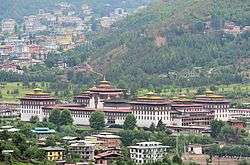
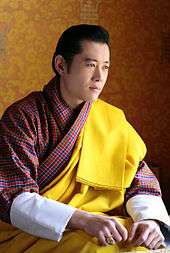
Bhutan is a constitutional monarchy with a parliamentary form of government, although scholar Dhurba Rizal has categorized it as a semi-democracy with only cosmetic or minor changes to the political structure prior to the absolute monarchy being abolished in the 2000s.[68] The reigning monarch is Jigme Khesar Namgyel Wangchuck. The current Prime Minister of Bhutan is Lotay Tshering, leader of the Druk Nyamrup Tshogpa Party.
The Druk Gyalpo (Dragon King) is the head of state.[69] The political system grants universal suffrage. It consists of the National Council, an upper house with 25 elected members; and the National Assembly with 47 elected lawmakers from political parties.
Executive power is exercised by the Council of Ministers led by the prime minister. Legislative power is vested in both the government and the National Assembly. Judicial power is vested in the courts. The legal system originates from the semi-theocratic Tsa Yig code and was influenced by English common law during the 20th century. The chief justice is the administrative head of the judiciary.
Political culture
The first general elections for the National Assembly were held on 24 March 2008. The chief contestants were the Bhutan Peace and Prosperity Party (DPT) led by Jigme Thinley and the People's Democratic Party (PDP) led by Sangay Ngedup. The DPT won the elections, taking 45 out of 47 seats.[70] Jigme Thinley served as Prime Minister from 2008 to 2013.
The People's Democratic Party came to power in the 2013 elections. It won 32 seats and 54.88% of the vote. PDP leader Tshering Tobgay served as Prime Minister from 2013 to 2018.
Druk Nyamrup Tshogpa won the largest number of seats in the 2018 National Assembly Election, bringing Lotay Tshering to premiership and Druk Nyamrup Tshogpa into the government for the first time.[71]
Women in government
Women in Bhutan tend to be less active in politics than men due to customs and aspects of Bhutan's culture that dictate a woman's role in the household.[72] This leads to a limitation of their voices in government. Bhutan has made steps toward gender equality by enrolling more girls in school as well as creating the National Commission for Women and Children (NCWC) in 2004.[73] This program was created to promote and protect women's and children's rights. Bhutan also elected its first female Dzongda, equivalent to a District Attorney, in 2012, and its first female minister in 2013.[73] Minister Dorji Choden is the chair for the National Bhutan Commission for Women and children and believes that this programme can be used to “promote women into more leadership roles” which can then lead women to take on more active roles in their society.[72] Overall there has also been a gradual increase in women in power with a 68% increase in women representation from 2011 to 2016.[73]
Foreign relations
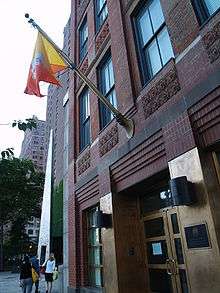

In the early 20th century, Bhutan's principal foreign relations were with British India and Tibet. The government of British India managed relations with the kingdom from the Bhutan House in Kalimpong. Fearful of Chinese communist expansion, Bhutan signed a friendship treaty with the newly independent Republic of India in 1949. Its concerns were exacerbated after the Chinese incorporation of Tibet.[75] Relations with Nepal remained strained due to Bhutanese refugees. Bhutan joined the United Nations in 1971. It was the first country to recognize Bangladesh's independence in 1971. It became a founding member of the South Asian Association for Regional Cooperation (SAARC) in 1985. The country is a member of 150 international organizations,[75] including the Bay of Bengal Initiative, BBIN, World Bank, the International Monetary Fund and the Group of 77.
Bhutan maintains strong economic, strategic, and military relations with India.[76][77] In 2007 Bhutan and India revised their friendship treaty, which clarified Bhutan's full control of its foreign relations, including its border with China. Bhutan has very warm relations with Japan, which provides significant development assistance. The Bhutanese royals were hosted by the Japanese imperial family during a state visit in 2011. Japan is also helping Bhutan cope with glacial floods through developing an early warning system.
Bhutan enjoys strong political and diplomatic relations with Bangladesh. The Bhutanese king was the guest of honour during celebrations of the 40th anniversary of Bangladesh's independence.[78] A 2014 joint statement by the prime ministers of both countries announced cooperation in areas of hydropower, river management and climate change mitigation.[79]
Bhutan has diplomatic relations with 52 countries and the European Union and has missions in India, Bangladesh, Thailand, Kuwait and Belgium. It has two UN missions, one in New York and one in Geneva. Only India, Bangladesh and Kuwait have residential embassies in Bhutan. Other countries maintain informal diplomatic contact via their embassies in New Delhi and Dhaka. Bhutan maintains formal diplomatic relations with several Asian and European nations, Canada, and Brazil. Other countries, such as the United States and the United Kingdom, have no formal diplomatic relations with Bhutan but maintain informal contact through their respective embassies in New Delhi and the Bhutanese honorary consulate in Washington, DC. The United Kingdom has an honorary consul resident in Thimphu.[80][81][82]

By a long-standing agreement, Indian and Bhutanese citizens may travel to each other's countries without a passport or visa, but must still have their national identity cards. Bhutanese citizens may also work in India without legal restriction. Bhutan does not have formal diplomatic ties with China, but exchanges of visits at various levels between them have significantly increased in recent times. The first bilateral agreement between China and Bhutan was signed in 1998 and Bhutan has also set up honorary consulates in the Special Administrative Regions of Hong Kong and Macau.[83] Bhutan's border with China is largely not demarcated and thus disputed in some places. Approximately 269 square kilometres remain under discussion between China and Bhutan.[84]
On 13 November 2005, Chinese soldiers crossed into the disputed territories between China and Bhutan and began building roads and bridges.[85] Bhutanese Foreign Minister Khandu Wangchuk took up the matter with Chinese authorities after the issue was raised in the Bhutanese parliament. In response, Foreign Ministry spokesman Qin Gang of the People's Republic of China said that the border remains in dispute and that the two sides are continuing to work for a peaceful and cordial resolution of the dispute, denying that the presence of soldiers in the area was an attempt to forcibly occupy it.[86] An Indian intelligence officer said that a Chinese delegation in Bhutan told the Bhutanese they were "overreacting". The Bhutanese newspaper Kuensel said that China might use the roads to further Chinese claims along the border.[85]
In February 2007 the Indo-Bhutan Friendship Treaty was substantially revised. Whereas the Treaty of 1949, Article 2 stated: "The Government of India undertakes to exercise no interference in the internal administration of Bhutan. On its part the Government of Bhutan agrees to be guided by the advice of the Government of India in regard to its external relations," the revised treaty now states "In keeping with the abiding ties of close friendship and cooperation between Bhutan and India, the Government of the Kingdom of Bhutan and the Government of the Republic of India shall cooperate closely with each other on issues relating to their national interests. Neither government shall allow the use of its territory for activities harmful to the national security and interest of the other." The revised treaty also includes this preamble: "Reaffirming their respect for each other's independence, sovereignty and territorial integrity", an element absent in the earlier version. The Indo-Bhutan Friendship Treaty of 2007 clarifies Bhutan's status as an independent and sovereign nation.
Military
The Royal Bhutan Army is Bhutan's military service. It includes the royal bodyguard and the Royal Bhutan Police. Membership is voluntary and the minimum age for recruitment is 18. The standing army numbers about 16,000 and is trained by the Indian Army.[87] It has an annual budget of about US$13.7 million (1.8 percent of GDP). As a landlocked country, Bhutan has no navy. It also has no air force or army aviation corps. The Army relies on the Eastern Air Command of the Indian Air Force for air assistance.
Human rights
Homosexual acts are illegal in Bhutan.[88] The Penal Code (Articles 213 & 214) states that same-sex sexual acts (regardless of whether they were consensual or private) are punishable by a prison sentence of between one month to less than one year.[89] Some members of the Parliament of Bhutan have publicly called for the anti-gay laws to be repealed, as a majority of Bhutanese oppose them.[90]
Ethnic conflict

In the 1990s, Bhutan expelled or forced to leave most of its ethnic Lhotshampa population, one-fifth of the country's population, demanding conformity in religion, dress, and language.[39][40][41] Lhotshampas were arrested and expelled from the country and their property was expropriated.[91]
A harassment campaign escalating in the early 1990s ensued, and afterwards Bhutanese security forces began expelling people. According to the UNHCR, more than 107,000 Bhutanese refugees living in seven camps in eastern Nepal have been documented as of 2008.[41] After many years in refugee camps, many inhabitants are now moving to other host nations such as Canada, Norway, the UK, Australia, and the US as refugees. The US admitted 60,773 refugees from fiscal years 2008 to 2012.[42]
The Nepalese government does not permit citizenship for Bhutanese refugees, so most of them have become stateless.[92] Careful scrutiny has been used to prevent their relatives from getting ID cards and voting rights.[92] Bhutan considers political parties associated with these refugees to be illegal and terrorist.[92] Human rights groups initially claimed the government interfered with individual rights by requiring all citizens, including ethnic minority members, to wear the traditional dress of the ethnic majority in public places. The government strictly enforced this law in Buddhist religious buildings, government offices, schools, official functions, and public ceremonies.[92]
Political divisions
Bhutan is divided into twenty Dzongkhag (districts), administered by a body called the Dzongkhag Tshogdu. In certain thromdes (urban municipalities), a further municipal administration is directly subordinate to the Dzongkhag administration. In the vast majority of constituencies, rural geog (village blocks) are administered by bodies called the Geog Tshogde.[93]
Thromdes (municipalities) elect Thrompons to lead administration, who in turn represent the Thromde in the Dzongkhag Tshogdu. Likewise, geog elect headmen called gups, vice-headmen called mangmis, who also sit on the Dzongkhag Tshogdu, as well as other members of the Geog Tshogde. The basis of electoral constituencies in Bhutan is the chiwog, a subdivision of gewogs delineated by the Election Commission.[93]
| Dzongkhags of the Kingdom of Bhutan | |||
|---|---|---|---|
| District | Dzongkha name | District | Dzongkha name |
| 1. Bumthang | བུམ་ཐང་རྫོང་ཁག་ | 11. Samdrup Jongkhar | བསམ་གྲུབ་ལྗོངས་མཁར་རྫོང་ཁག་ |
| 2. Chukha | ཆུ་ཁ་རྫོང་ཁག་ | 12. Samtse | བསམ་རྩེ་རྫོང་ཁག་ |
| 3. Dagana | དར་དཀར་ན་རྫོང་ཁག་ | 13. Sarpang | གསར་སྤང་རྫོང་ཁག་ |
| 4. Gasa | མགར་ས་རྫོང་ཁག་ | 14. Thimphu | ཐིམ་ཕུ་རྫོང་ཁག་ |
| 5. Haa | ཧཱ་རྫོང་ཁག་ | 15. Trashigang | བཀྲ་ཤིས་སྒང་རྫོང་ཁག་ |
| 6. Lhuntse | ལྷུན་རྩེ་རྫོང་ཁག་ | 16. Trashiyangtse | བཀྲ་ཤིས་གཡང་རྩེ་རྫོང་ཁག་ |
| 7. Mongar | མོང་སྒར་རྫོང་ཁག་ | 17. Trongsa | ཀྲོང་གསར་རྫོང་ཁག་ |
| 8. Paro | སྤ་རོ་རྫོང་ཁག་ | 18. Tsirang | རྩི་རང་རྫོང་ཁག་ |
| 9. Pemagatshel | པད་མ་དགའ་ཚལ་རྫོང་ཁག་ | 19. Wangdue Phodrang | དབང་འདུས་ཕོ་བྲང་རྫོང་ཁག་ |
| 10. Punakha | སྤུ་ན་ཁ་རྫོང་ཁག་ | 20. Zhemgang | གཞམས་སྒང་རྫོང་ཁག་ |
Economy
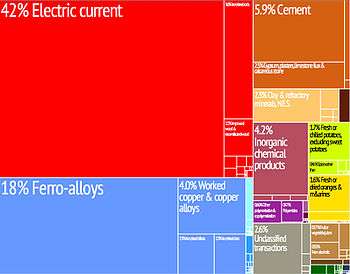

Bhutan's currency is the ngultrum, whose value is fixed to the Indian rupee. The rupee is also accepted as legal tender in the country. Though Bhutan's economy is one of the world's smallest,[95] it has grown rapidly in recent years, by eight percent in 2005 and 14 percent in 2006. In 2007, Bhutan had the second-fastest-growing economy in the world, with an annual economic growth rate of 22.4 percent. This was mainly due to the commissioning of the gigantic Tala Hydroelectric Power Station. As of 2012, Bhutan's per capita income was US$2,420.[96]
Bhutan's economy is based on agriculture, forestry, tourism and the sale of hydroelectric power to India. Agriculture provides the main livelihood for 55.4 percent of the population.[97] Agrarian practices consist largely of subsistence farming and animal husbandry. Handicrafts, particularly weaving and the manufacture of religious art for home altars, are a small cottage industry. A landscape that varies from hilly to ruggedly mountainous has made the building of roads and other infrastructure difficult and expensive.
This, and a lack of access to the sea, has meant that Bhutan has not been able to benefit from significant trading of its produce. Bhutan has no railways, though Indian Railways plans to link southern Bhutan to its vast network under an agreement signed in January 2005.[98] Bhutan and India signed a 'free trade' accord in 2008, which additionally allowed Bhutanese imports and exports from third markets to transit India without tariffs.[99] Bhutan had trade relations with the Tibet Autonomous Region of China until 1960, when it closed its border with China after an influx of refugees.[100]
Access to biocapacity in Bhutan is much higher than world average. In 2016, Bhutan had 5.0 global hectares [101] of biocapacity per person within its territory, much more than the world average of 1.6 global hectares per person.[102] In 2016 Bhutan used 4.5 global hectares of biocapacity per person - their ecological footprint of consumption. This means they use less biocapacity than Bhutan contains. As a result, Bhutan is running a biocapacity reserve.[101]
The industrial sector is in a nascent stage, and though most production comes from cottage industry, larger industries are being encouraged and some industries such as cement, steel, and ferroalloy have been set up. Most development projects, such as road construction, rely on Indian contract labour. Agricultural produce includes rice, chilies, dairy (some yak, mostly cow) products, buckwheat, barley, root crops, apples, and citrus and maize at lower elevations. Industries include cement, wood products, processed fruits, alcoholic beverages and calcium carbide.
Bhutan has seen recent growth in the technology sector, in areas such as green tech and consumer Internet/e-commerce.[103] In May 2012, Thimphu TechPark launched in the capital and incubates start-ups via the Bhutan Innovation and Technology Centre (BITC).[104]
Incomes of over Nu 100,000 per annum are taxed, but very few wage and salary earners qualify. Bhutan's inflation rate was estimated at about three percent in 2003. Bhutan has a gross domestic product of around US$5.855 billion (adjusted to purchasing power parity), making it the 158th-largest economy in the world. Per capita income (PPP) is around $7,641,[47] ranked 144th. Government revenues total $407.1 million, though expenditures amount to $614 million. Twenty-five percent of the budget expenditure, however, is financed by India's Ministry of External Affairs.[note 1][105]
Bhutan's exports, principally electricity, cardamom, gypsum, timber, handicrafts, cement, fruit, precious stones and spices, total €128 million (2000 est.). Imports, however, amount to €164 million, leading to a trade deficit. Main items imported include fuel and lubricants, grain, machinery, vehicles, fabrics and rice. Bhutan's main export partner is India, accounting for 58.6 percent of its export goods. Hong Kong (30.1 percent) and Bangladesh (7.3 percent) are the other two top export partners.[47] As its border with Tibet Autonomous Region is closed, trade between Bhutan and China is now almost non-existent. Bhutan's import partners include India (74.5 percent), Japan (7.4 percent) and Sweden (3.2 percent).
Agriculture
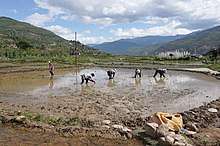
The share of the agricultural sector in GDP declined from approximately 55% in 1985 to 33% in 2003. In 2013 the government announced the aspiration that Bhutan will become the first country in the world with 100 percent organic farming.[106][107] Bhutanese red rice is the country's most widely known agricultural export, enjoying a market in North America and Europe. Bangladesh is the largest market of Bhutanese apples and oranges.[108]
Fishing in Bhutan is mainly centered on trout and carp.
Industry
The industrial sector accounts for 22% of the economy. The key manufacturing sectors in Bhutan include production of ferroalloy, cement, metal poles, iron and nonalloy steel products, processed graphite, copper conductors, alcoholic and carbonated beverages, processed fruits, carpets, wood products and furniture.[109]
Mining
Bhutan has deposits of numerous minerals. Commercial production includes coal, dolomite, gypsum, and limestone. The country has proven reserves of beryl, copper, graphite, lead, mica, pyrite, tin, tungsten, and zinc. However, the country remains as an environmental frontier as it prefers to conserve the environment, rather than to exploit and destroy it for money.[110]
Energy
Bhutan's largest export is hydroelectricity. As of 2015, it generates about 2,000 MW of hydropower from Himalayan river valleys.[111] The country has a potential to generate 30,000 MW of hydropower.[111] Power is supplied to various states in India. Future projects are being planned with Bangladesh.[111] Hydropower has been the primary focus for the country's five-year plans. As of 2015, the Tala Hydroelectric Power Station is its largest power plant, with an installed capacity of 1,020 MW. It has received assistance from India, Austria and the Asian Development Bank in developing hydroelectric projects. Besides hydropower, it is also endowed with significant renewable energy resources such as solar, wind and bioenergy. Technically viable solar energy generation capacity is around 12,000 MW and wind around 760 MW. More than 70% of its land is under forest cover, which is an immense source of bioenergy in the country.
Bhutan is likely to benefit geopolitically from the global transition to renewable energy and is ranked no. 4 out of 156 nations in the index of geopolitical gains and losses after energy transition (GeGaLo Index).[112]
Financial sector
.jpg)
There are Five Commercial Banks in the country and two largest banks are the Bank of Bhutan and the Bhutan National Bank which are based in Thimphu. Other commercial banks are Bhutan Development Bank, T-Bank and Druk Punjab National Bank. The country's financial sector is also supported by other non-banking Financial Institutions. They are Royal Insurance Corporation of Bhutan (RICB), National Pension and Provident Fund (NPPF), and Bhutan Insurance Limited (BIL). The central bank of the country is the Royal Monetary Authority of Bhutan (RMA). The Royal Securities Exchange of Bhutan is the main stock exchange. B The SAARC Development Fund is based in Thimphu.[113]
Tourism
In 2014, Bhutan welcomed 133,480 foreign visitors.[114] Seeking to become a high-value destination, it imposes a daily fee of anywhere between US$180 to US$290 per day (or more) on tourists that covers touring and hotel accommodation.[115][116] The industry employs 21,000 people and accounts for 1.8% of GDP.[117] However the Buthanese goal of attracting high value tourists can be criticized for actually only attracting wealthy tourists and poses the question on whether by definition "high quality" actually means "of wealth".[118][119]
The country currently has no UNESCO World Heritage Sites, but it has eight declared tentative sites for UNESCO inclusion since 2012. These sites include Ancient Ruin of Drukgyel Dzong,[120] Bumdelling Wildlife Sanctuary,[121] Dzongs: the centre of temporal and religious authorities (Punakha Dzong, Wangdue Phodrang Dzong, Paro Dzong, Trongsa Dzong and Dagana Dzong),[122] Jigme Dorji National Park (JDNP),[123] Royal Manas National Park (RMNP),[124] Sacred Sites associated with Phajo Drugom Zhigpo and his descendants,[125] Sakteng Wildlife Sanctuary (SWS),[126] and Tamzhing Monastery.[127] Bhutan also has numerous tourist sites that are not included in its UNESCO tentative list. Bhutan has one element, the Mask dance of the drums from Drametse, registered in the UNESCO Intangible Cultural Heritage List.[128]
Bhutan is also well known for mountain adventure trekking and hiking. Jhomolhari Base Camp Trek, Snowman Trek, and Masagang trek are some of the popular treks in Bhutan.
Transport
Air
Paro Airport is the only international airport in Bhutan. Yongphulla Airport in Trashigang is a small domestic airport that underwent upgrades through 2010.[129] Yonphula Domestic Airport was scheduled for completion in January 2010 but as of January 2015, the airport remains closed due to ongoing runway repair.[130] National carrier Druk Air operates flights between Paro Airport and airports in Jakar (Bumthang Dzongkhag) and Gelephu (Sarpang Dzongkhag) on a weekly basis.[131]
Road
The Lateral Road is Bhutan's primary east–west corridor, connecting Phuentsholing in the southwest to Trashigang in the east. In between, the Lateral Road runs directly through Wangdue Phodrang, Trongsa and other population centres. The Lateral Road also has spurs connecting to the capital Thimphu and other major population centres such as Paro and Punakha. As with other roads in Bhutan, the Lateral Road presents serious safety concerns due to pavement conditions, sheer drops, hairpin turns, weather and landslides.[132][133][134]
Since 2014, road widening has been a priority across Bhutan, in particular for the north-east–west highway from Trashigang to Dochula. The widening project is expected to be completed by the end of 2017 and will make road travel across the country substantially faster and more efficient. In addition, it is projected that the improved road conditions will encourage more tourism in the more inaccessible eastern region of Bhutan.[135][136][137] Currently, the road conditions appear to be deterring tourists from visiting Bhutan due to the increased instances of road blocks, landslides and dust disruption caused by the widening project.[138]
Rail
Bhutan has no railways, though it has entered into an agreement with India to link southern Bhutan to India's vast network by constructing an 18-kilometre-long (11 mi) 1,676 mm (5 ft 6 in) broad gauge rail link between Hashimara in West Bengal and Toribari in Bhutan. The construction of the railway via Satali, Bharna Bari and Dalsingpara by Indian railways will be funded by India.[139] Bhutan's nearest railway station is Hasimara.
Demographics
| Year | Pop. | ±% |
|---|---|---|
| 1960 | 224,000 | — |
| 1980 | 413,000 | +84.4% |
| 1990 | 536,000 | +29.8% |
| 1995 | 509,000 | −5.0% |
| 2005 | 650,000 | +27.7% |
| Source: http://esa.un.org/unpd/wpp/unpp/panel_population.htm | ||
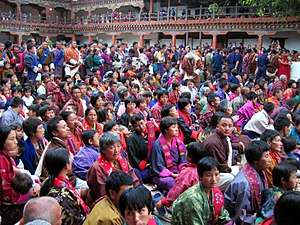
Bhutan had a population of 754,388 people in 2018.[3][4] Bhutan has a median age of 24.8 years.[47] There are 1,070 males to every 1,000 females. The literacy rate in Bhutan is 59.5 percent.[140]
Ethnic groups
Bhutanese people primarily consist of the Ngalops and Sharchops, called the Western Bhutanese and Eastern Bhutanese respectively. Although the Sharchops are slightly larger in demographic size, the Ngalops dominate the political sphere, as the King and the political elite belong to this group.[141] The Ngalops primarily consist of Bhutanese living in the western part of the country. Their culture is closely related to that of Tibet. Much the same could be said of the Sharchops, the largest group, who traditionally follow the Nyingmapa rather than the official Drukpa Kagyu form of Tibetan Buddhism. In modern times, with improved transportation infrastructure, there has been much intermarriage between these groups.
The Lhotshampa, meaning "southerner Bhutanese", are a heterogeneous group of mostly Nepalese ancestry. It was claimed that they constituted 45% of the population in the 1988 census,[142] and include migrants from as early as the 1890s to as recent as the 1980s, who have fought a bitter war with Bhutan over rights to abode, language, and dress. In the early 1970s, intermarriage between the Lhotshampas Bhutanese and mainstream Bhutanese society was encouraged by the government, but after the late 1980s, the Bhutanese government forced about 108,000 Lhotshampas from their homes, seized their land, and expelled them to refugee camps.[91] Consequently, there has been mass emigration from Bhutan (both forced and voluntary) and ethnic cleansing in Bhutan resulting in hundreds of thousands of people left stateless in refugee camps of Nepal.[91] Currently, Lhotsampa are estimated to make up approximately 20% of Bhutan's population.[141]
Cities and towns
- Thimphu, the largest city and capital of Bhutan.
- Damphu, the administrative headquarters of Tsirang District.
- Jakar, the administrative headquarters of Bumthang District and the place where Buddhism entered Bhutan.
- Mongar, the eastern commercial hub of the country.
- Paro, site of the international airport.
- Phuentsholing, Bhutan's commercial hub.
- Punakha, the old capital.
- Samdrup Jongkhar, the southeastern town on the border with India.
- Trashigang, administrative headquarters of Trashigang District, the most populous district in the country.
- Trongsa, in central Bhutan, which has the largest and the most magnificent of all the dzongs in Bhutan.
Religion
Religion in Bhutan (Pew 2010)[144]
It is estimated that between two-thirds and three-quarters of the Bhutanese population follow Vajrayana Buddhism, which is also the state religion. About one-quarter to one-third are followers of Hinduism. Other religions account for less than 1% of the population.[145] The current legal framework, in principle guarantees freedom of religion; proselytism, however, is forbidden by a royal government decision[145] and by judicial interpretation of the Constitution.[146]
Buddhism was introduced to Bhutan in the 7th century AD. Tibetan king Songtsän Gampo (reigned 627–649), a convert to Buddhism, ordered the construction of two Buddhist temples, at Bumthang in central Bhutan and at Kyichu Lhakhang (near Paro) in the Paro Valley.[27]
Languages
The national language is Dzongkha (Bhutanese), one of 53 languages in the Tibetan language family. The script, here called Chhokey ("Dharma language"), is identical to classical Tibetan. In the schools English is the medium of instruction and Dzongkha is taught as the national language. Ethnologue lists 24 languages currently spoken in Bhutan, all of them in the Tibeto-Burman family, except Nepali, an Indo-Aryan language.[40]
Until the 1980s, the government sponsored the teaching of Nepali in schools in southern Bhutan. With the adoption of Driglam Namzhag and its expansion into the idea of strengthening the role of Dzongkha, Nepali was dropped from the curriculum. The languages of Bhutan are still not well characterized, and several have yet to be recorded in an in-depth academic grammar. Before the 1980s, the Lhotshampa (Nepali-speaking community), mainly based in southern Bhutan, constituted approximately 30% of the population.[40] However, after a purge of Lhotshaampas from 1990–1992 this number might not accurately reflect the current population.
Dzongkha is partially intelligible with Sikkimese and spoken natively by 25% of the population. Tshangla, the language of the Sharchop and the principal pre-Tibetan language of Bhutan, is spoken by a greater number of people. It is not easily classified and may constitute an independent branch of Tibeto-Burman. Nepali speakers constituted some 40% of the population as of 2006. The larger minority languages are Dzala (11%), Limbu (10%), Kheng (8%), and Rai (8%). There are no reliable sources for the ethnic or linguistic composition of Bhutan, so these numbers do not add up to 100%.
Health
Bhutan has a life expectancy of 70.2 years (69.9 for males and 70.5 for females) according to the latest data for 2016 from the World Bank.[147]
Source: UN World Population Prospects[148]
Basic healthcare in Bhutan is free, as provided by the Constitution of Bhutan.[149]
Education
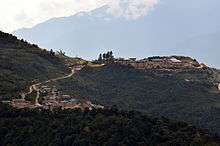
Bhutan has two decentralized universities with eleven constituent colleges spread across the kingdom, the Royal University of Bhutan and Khesar Gyalpo University of Medical Sciences. The first five-year plan provided for a central education authority—in the form of a director of education appointed in 1961—and an organized, modern school system with free and universal primary education.
Education programmes were given a boost in 1990 when the Asian Development Bank (see Glossary) granted a US$7.13 million loan for staff training and development, specialist services, equipment and furniture purchases, salaries and other recurrent costs, and facility rehabilitation and construction at Royal Bhutan Polytechnic.
Since the beginning of education in Bhutan, teachers from India, especially Kerala have served in some of the most remote villages of Bhutan. In honour of their service, 43 retired teachers who served for the longest time were invited to Thimphu, Bhutan during the teachers day celebrations in 2018 and individually thanked by His Majesty Jigme Khesar Namgyel Wangchuck. To celebrate 50 years of diplomatic relations between Bhutan and India, 80 teachers who served in Bhutan were honoured by the Education Minister Jai Bir Rai at a special ceremony organized at Kolkata, India on 6 January 2019.[150] Currently, there are 121 teachers from India placed in schools across Bhutan.
Culture
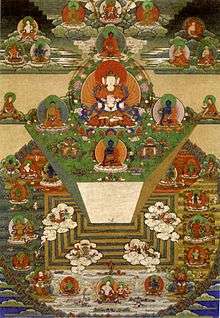
Bhutan has a rich and unique cultural heritage that has largely remained intact because of its isolation from the rest of the world until the mid-20th century. One of the main attractions for tourists is the country's culture and traditions. Bhutanese tradition is deeply steeped in its Buddhist heritage.[151][152] Hinduism is the second most dominant religion in Bhutan, being most prevalent in the southern regions.[153] The government is increasingly making efforts to preserve and sustain the current culture and traditions of the country. Because of its largely unspoiled natural environment and cultural heritage, Bhutan has been referred to as The Last Shangri-La.[154]
While Bhutanese citizens are free to travel abroad, Bhutan is viewed as inaccessible by many foreigners. Another reason for it being an unpopular destination is the cost, which is high for tourists on tighter budgets. Entry is free for citizens of India, Bangladesh, and the Maldives, but all other foreigners are required to sign up with a Bhutanese tour operator and pay around US$250 per day that they stay in the country, though this fee covers most travel, lodging and meal expenses.[155] Bhutan received 37,482 visitor arrivals in 2011, of which 25% were for meetings, incentives, conferencing, and exhibitions.[156]
Bhutan is the first nation in the world to ban smoking. It has been illegal to smoke in public or sell tobacco, according to Tobacco Control Act of Bhutan 2010. Violators are fined the equivalent of $232—a month's salary in Bhutan.
Dress
The national dress for Bhutanese men is the gho, a knee-length robe tied at the waist by a cloth belt known as the kera. Women wear an ankle-length dress, the kira, which is clipped at the shoulders with two identical brooches called the koma and tied at the waist with kera. An accompaniment to the kira is a long-sleeved blouse, the wonju which is worn underneath the kira. A long-sleeved jacket-like garment, the toego is worn over the kira. The sleeves of the wonju and the tego are folded together at the cuffs, inside out.
Social status and class determine the texture, colours, and decorations that embellish the garments. Differently coloured scarves, known as rachu for women (red is the most common colour) and kabney for men, are important indicators of social standing, as Bhutan has traditionally been a feudal society. Jewellery is mostly worn by women, especially during religious festivals (tsechus) and public gatherings. To strengthen Bhutan's identity as an independent country, Bhutanese law requires all Bhutanese government employees to wear the national dress at work and all citizens to wear the national dress while visiting schools and other government offices though many citizens, particularly adults, choose to wear the customary dress as formal attire.
Architecture
Bhutanese architecture remains distinctively traditional, employing rammed earth and wattle and daub construction methods, stone masonry, and intricate woodwork around windows and roofs. Traditional architecture uses no nails or iron bars in construction.[34][157][158] Characteristic of the region is a type of castle fortress known as the dzong. Since ancient times, the dzongs have served as the religious and secular administration centres for their respective districts.[159] The University of Texas at El Paso in the United States has adopted Bhutanese architecture for its buildings on campus, as have the nearby Hilton Garden Inn and other buildings in the city of El Paso.[160]
Public holidays
Bhutan has numerous public holidays, most of which coincide with traditional, seasonal, secular or religious festivals. They include the winter solstice (around 1 January, depending on the lunar calendar),[161] Lunar New Year (February or March),[162] the King's birthday and the anniversary of his coronation, the official end of monsoon season (22 September),[163] National Day (17 December),[164] and various Buddhist and Hindu celebrations.
Film industry
Music and dance
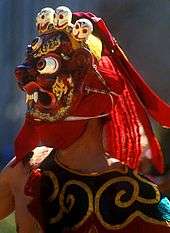
Masked dances and dance dramas are common traditional features at festivals, usually accompanied by traditional music. Energetic dancers, wearing colourful wooden or composition face masks and stylized costumes, depict heroes, demons, dæmons, death heads, animals, gods, and caricatures of common people. The dancers enjoy royal patronage, and preserve ancient folk and religious customs and perpetuate the ancient lore and art of mask-making.
The music of Bhutan can generally be divided into traditional and modern varieties; traditional music comprises religious and folk genres, the latter including zhungdra and boedra.[165] The modern rigsar is played on a mix of traditional instruments and electronic keyboards, and dates back to the early 1990s; it shows the influence of Indian popular music, a hybrid form of traditional and Western popular influences.[166][167]
Family structure
In Bhutanese families, inheritance generally passes matrilineally through the female rather than the male line. Daughters will inherit their parents' house. A man is expected to make his own way in the world and often moves to his wife's home. Love marriages are more common in urban areas, but the tradition of arranged marriages among acquainted families is still prevalent in most of the rural areas. Although uncommon, polygamy is accepted, often being a device to keep property in a contained family unit rather than dispersing it.[168] The previous king, Jigme Singye Wangchuck, who abdicated in 2006, had four queens, all of whom are sisters. The current king, Jigme Khesar Namgyel Wangchuck, wed Jetsun Pema, 21, a commoner and daughter of a pilot, on 13 October 2011.
Cuisine

Rice (red rice), buckwheat, and increasingly maize, are the staples of Bhutanese cuisine. The local diet also includes pork, beef, yak meat, chicken, and lamb. Soups and stews of meat and dried vegetables spiced with chilies and cheese are prepared. Ema datshi, made very spicy with cheese and chilies, might be called the national dish for its ubiquity and the pride that Bhutanese have for it. Dairy foods, particularly butter and cheese from yaks and cows, are also popular, and indeed almost all milk is turned into butter and cheese. Popular beverages include butter tea, black tea, locally brewed ara (rice wine), and beer. Bhutan is the first country in the world to have banned the sale of tobacco under its Tobacco Act of 2010.[34]
Sports
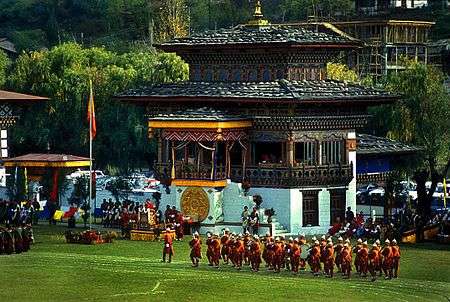
Bhutan's national and most popular sport is archery.[169] Competitions are held regularly in most villages. It differs from Olympic standards in technical details such as the placement of the targets and atmosphere. Two targets are placed over 100 meters apart, and teams shoot from one end of the field to the other. Each member of the team shoots two arrows per round. Traditional Bhutanese archery is a social event, and competitions are organized between villages, towns, and amateur teams. There is usually plenty of food and drink complete with singing and dancing. Attempts to distract an opponent include standing around the target and making fun of the shooter's ability. Darts (khuru) is an equally popular outdoor team sport, in which heavy wooden darts pointed with a 10 cm nail are thrown at a paperback-sized target 10 to 20 meters away.
Another traditional sport is the Digor, which resembles the shot put and horseshoe throwing.
Another popular sport is basketball.[169] In 2002, Bhutan's national football team played Montserrat, in what was billed as The Other Final; the match took place on the same day Brazil played Germany in the World Cup final, but at the time Bhutan and Montserrat were the world's two lowest ranked teams. The match was held in Thimphu's Changlimithang National Stadium, and Bhutan won 4–0. A documentary of the match was made by the Dutch filmmaker Johan Kramer. Bhutan won its first two FIFA World Cup Qualifying matches, beating Sri Lanka 1–0 in Sri Lanka and 2–1 in Bhutan, taking the aggregate at 3–1.[170] Cricket has also gained popularity in Bhutan, particularly since the introduction of television channels from India. The Bhutan national cricket team is one of the most successful affiliate nations in the region.
Women in the workforce
Women have begun to participate more in the work force and their participation is one of the highest in the region.[73] However, the unemployment rates among women are still higher than those of men and women are in more unsecure work fields, such as agriculture.[171] Most of the work that women do outside of the home is in family-based agriculture which is insecure and is one of the reasons why women are falling behind men when it comes to income.[73] Women also, in general, work lower-quality jobs than men and only earn 75% of men's earnings.[172] The unemployment rate among women is also higher than that of men.[171]
Women in the household
Rooted deep in Bhutan culture is the idea of selflessness and the women of Bhutan take on this role in the context of the household.[173] Bhutan culture has shown a tolerance for domestic violence with nearly 1/4 of all women having had experienced some form of violence from their husband or partner.[171] Some Bhutanese communities have what is referred to as matrilineal communities, where the eldest daughter receives the largest share of the land.[172] This is due to the belief that she will stay and take care of her parents while the son will move out and work to get his own land and for his own family.[172] Importantly, land ownership does not necessarily equate to economic benefits - despite the eldest daughter having control of the house, it is the husband that is in charge of making decisions.[172] However, the younger generation has stepped away from this belief in splitting the land evenly between the children instead of the eldest daughter inheriting the most land.[172]
Women's health
Throughout Bhutan there has been an improvement in reproductive health services and there has been a drastic drop in maternal mortality rate, dropping from 1,000 in 1990 to 180 in 2010.[172] There has also been an increase in contraceptive use from less than 1/3 in 2003 to 2/3 in 2010.[172]
Notes
- India's Ministry of External Affairs provides financial aid to neighbouring countries under "technical and economic cooperation with other countries and advances to foreign governments."
References
- "9th Five Year Plan (2002–2007)" (PDF). Royal Government of Bhutan. 2002. Archived from the original (PDF) on 20 March 2012. Retrieved 22 August 2011.
- "National Portal of Bhutan". Department of Information Technology, Bhutan. Archived from the original on 23 April 2012. Retrieved 22 August 2011.
- ""World Population prospects – Population division"". population.un.org. United Nations Department of Economic and Social Affairs, Population Division. Retrieved 9 November 2019.
- ""Overall total population" – World Population Prospects: The 2019 Revision" (xslx). population.un.org (custom data acquired via website). United Nations Department of Economic and Social Affairs, Population Division. Retrieved 9 November 2019.
- "Bhutan". Citypopulation.de. Retrieved 7 May 2019.
- "Butan". International Monetary Fund.
- "Gini Index". World Bank. Archived from the original on 8 June 2014. Retrieved 22 September 2019.
- "Human Development Report 2019" (PDF). United Nations Development Programme. 10 December 2019. Retrieved 10 December 2019.
- "Treaty Bodies Database – Document – Summary Record – Bhutan". Office of the United Nations High Commissioner for Human Rights (UNHCHR). 5 June 2001. Archived from the original on 10 January 2009. Retrieved 23 April 2009.
- "World Population Prospects". United Nations. 2008. Archived from the original on 7 January 2010. Retrieved 4 December 2009.
- Driem, George van (1998). Dzongkha = Rdoṅ-kha. Leiden: Research School, CNWS. p. 478. ISBN 978-90-5789-002-4.
- Dalrymple, William (23 March 2008). "What use is democracy to idyllic Bhutan?". The Telegraph. ISSN 0307-1235. Archived from the original on 24 October 2017. Retrieved 24 October 2017.
- Tsuguyasu Itami (October 2001). "Gankarpunzum & First Ascent Of Liankang Kangri" (PDF). Japanese Alpine News. 1. Archived (PDF) from the original on 3 March 2016. Retrieved 14 March 2018.
- "Bhutan's Hydropower Sector: 12 Things to Know". Asian Development Bank. 30 January 2014. Archived from the original on 4 March 2016. Retrieved 17 June 2016.
- "Bhutan's Gross National Happiness Index | OPHI". www.ophi.org.uk. Archived from the original on 8 October 2017. Retrieved 2 October 2017.
- Chakravarti, Balaram (1979). A Cultural History of Bhutan. 1. Hilltop. p. 7. Archived from the original on 12 January 2016. Retrieved 18 October 2015.
- Taylor, Isaac (1898). Names and Their Histories: A Handbook of Historical Geography and Topographical Nomenclature. Gale Research Co. p. 69.
- U.S. Library of Congress, Country Studies, Bhutan, HISTORICAL SETTING, BHUTAN Origins and Early Settlement, A.D. 600–1600, http://lcweb2.loc.gov/cgi-bin/query/r?frd/cstdy:@field(DOCID+bt0014) Archived 28 September 2017 at the Wayback Machine
- "History of Bhutan: How Europe heard about Bhutan". Kuensel. 24 August 2003. Retrieved 28 September 2011.
- Cacella, Estêvão. Trans. by Baillie, Luiza Maria. "Report which Father Estevao Cacella of the Society of Jesus Sent to Father Alberto Laercio, Provincial of the Province of Malabar of East India, about His Journey to Cathay, until He Came to the Kingdom of Bhotanta" Archived 25 January 2012 at the Wayback Machine (1627). Retrieved 28 September 2011.
- Grange, Kevin (2011). Beneath Blossom Rain: Discovering Bhutan on the Toughest Trek in the World. Outdoor Lives. University of Nebraska Press. ISBN 978-0-8032-3433-8. Retrieved 18 October 2015.
- Clements, William M. (2006). The Greenwood Encyclopedia of World Folklore and Folklife. The Greenwood Encyclopedia of World Folklore and Folklife: Southeast Asia and India, Central and East Asia, Middle East. 2. Greenwood Press. p. 105. ISBN 978-0-313-32849-7. Archived from the original on 12 January 2016. Retrieved 18 October 2015.
- "Bhutan". World Institute for Asian Studies. 21 August 2006. Archived from the original on 1 August 2009. Retrieved 23 April 2009.
-

- Padel, Ruth (2006). Tigers in Red Weather: a Quest for the Last Wild Tigers. Bloomsbury Publishing USA. pp. 139–40. ISBN 978-0-8027-1544-9. Archived from the original on 12 January 2016. Retrieved 18 October 2015.
- Sailen Debnath, Essays on Cultural History of North Bengal, ISBN 978-81-86860-42-7; & Sailen Debnath, The Dooars in Historical Transition, ISBN 978-81-86860-44-1
-

- Hattaway, Paul (2004). Peoples of the Buddhist World: a Christian Prayer Diary. William Carey Library. p. 30. ISBN 978-0-87808-361-9. Archived from the original on 12 January 2016. Retrieved 18 October 2015.
- Rennie, Frank; Mason, Robin (2008). Bhutan: Ways of Knowing. IAP. pp. 18, 58. ISBN 978-1-59311-734-4. Archived from the original on 12 January 2016. Retrieved 18 October 2015.
- Dorji, C. T. (1994). History of Bhutan Based on Buddhism. Sangay Xam, Prominent Publishers. ISBN 978-81-86239-01-8. Archived from the original on 12 April 2016. Retrieved 18 October 2015.
- Harding, Sarah (2003). The Life and Revelations of Pema Lingpa. Snow Lion Publications. ISBN 978-1-55939-194-8. Archived from the original on 12 January 2016. Retrieved 18 October 2015.
-

- Karma Phuntsho (2013). The History of Bhutan. Random House India. pp. 224–227. ISBN 9788184003116.
- Brown, Lindsay; Armington, Stan (2007). Bhutan. Country Guides (3 ed.). Lonely Planet. pp. 26, 36. ISBN 978-1-74059-529-2. Archived from the original on 6 December 2016. Retrieved 18 October 2015.
- Pomplun, Trent (2009). Jesuit on the Roof of the World: Ippolito Desideri's Mission to Eighteenth-Century Tibet. Oxford University Press. p. 49. ISBN 978-0-19-537786-6. Retrieved 18 October 2015.
-

-

- Hannavy, John (2013). Encyclopedia of Nineteenth-Century Photography. Routledge. p. 1496. ISBN 978-1-135-87327-1. Archived from the original on 12 January 2016. Retrieved 18 October 2015.
- "Family Portrait of Bhutan Nepalis in USA". The Week Republica. 15 April 2011. Archived from the original on 11 May 2011. Retrieved 19 April 2011.
- "Assessment for Lhotshampas in Bhutan". Database. Center for International Development and Conflict Management, University of Maryland. Archived from the original on 22 June 2012. Retrieved 9 August 2011.
- "Refugees from Bhutan Poised for New Start". UNHCR. 1 February 2008. Archived from the original on 10 May 2011. Retrieved 19 April 2011.
- Refugee Arrival Data Archived 7 December 2011 at the Wayback Machine. US Department of Health and Human Services, Office of Refugee Resettlement. 17 July 2012. Web. 25 December 2013.
- Hoffman, Klus (1 April 2006). "Democratization from Above: The Case of Bhutan" (PDF). Archived from the original (PDF) on 10 June 2011. Retrieved 24 April 2010.
- Larmer, Brook (March 2008). "Bhutan's Enlightened Experiment". National Geographic. ISSN 0027-9358. Archived from the original on 11 May 2011. Retrieved 19 June 2010.
- Scott-Clark, Cathy; Levy, Adrian (14 June 2003). "Fast Forward into Trouble". The Guardian. Retrieved 1 September 2011.
- Kaul, Nitasha (10 November 2008). "Bhutan Crowns a Jewel". UPI Asia. United Press International. Archived from the original on 15 June 2011. Retrieved 19 June 2011.
- "Bhutan – The World Factbook". Central Intelligence Agency. Archived from the original on 28 December 2010. Retrieved 1 February 2008.
- "List of Parties". Archived from the original on 24 January 2011. Retrieved 8 December 2012.
- "Biodiversity Action Plan 2009" (PDF). Archived (PDF) from the original on 7 May 2013. Retrieved 9 December 2012.
- Choudhury, A.U. (1990). "Primates in Bhutan". Oryx. 24 (3): 125. doi:10.1017/S0030605300033834.
- Choudhury, A.U. (1992). "Golden langur – Distribution Confusion". Oryx. 26 (3): 172–173. doi:10.1017/S0030605300023619.
- Choudhury, A.U. (2008). "Primates of Bhutan and Observations of Hybrid Langurs". Primate Conservation. 23: 65–73. doi:10.1896/052.023.0107.
- Choudhury, A.U. (2010). The Vanishing Herds: Wild Water Buffalo. Guwahati, India: Gibbon Books & The Rhino Foundation for Nature in North East India. ISBN 978-9380652009.
- Choudhury, A.U. (2007). "White-winged duck Cairina (=Asarcornis) scutulata and Blue-tailed Bee-eater Merops philippinus: two new country records for Bhutan" (PDF). Forktail. 23: 153–155. Archived (PDF) from the original on 15 July 2014. Retrieved 13 June 2014.
- Bisht, Ramesh Chandra (2008). International Encyclopaedia Of Himalayas (5 Vols. Set). Mittal Publications. p. 54. ISBN 9788183242653. Archived from the original on 4 December 2015. Retrieved 16 February 2015.
- "New IUCN State Members". Switzerland: IUCN Newsletter. January 2012. Archived from the original on 14 July 2014. Retrieved 7 July 2014.
- "Parks of Bhutan". Bhutan Trust Fund for Environmental Conservation online. Bhutan Trust Fund. Archived from the original on 2 July 2011. Retrieved 26 March 2011.
- "The Organisation". Bhutan Trust Fund for Environmental Conservation online. Bhutan Trust Fund. Archived from the original on 29 March 2010. Retrieved 26 March 2011.
- "Transcript of "This country isn't just carbon neutral – it's carbon negative"". Archived from the original on 22 April 2016. Retrieved 13 April 2016.
- Kingdom of Bhutan. Royal Government of Bhutan. National Environment Commission. Communication of INDC of the Kingdom of Bhutan. By Yeshay Dorji. Thimphu: NEC, 2015. Print.
- "Bhutan-Biodiversity Action Plan 2009" (PDF). Archived (PDF) from the original on 22 December 2015.
- Pashley, Alex. "Bhutan: climate lessons from a Himalayan kingdom". Climate Home – climate change news. Archived from the original on 18 December 2015. Retrieved 17 December 2015.
- "Bhutan must consider long term measure on climate change: UNFCCC's head – BBS". BBS. Archived from the original on 22 December 2015. Retrieved 17 December 2015.
- Tims-Lewechi. "Environmental degradations and response in third world countries: a study on the republic of bhutan".
- Wangchuk, Jigme (8 July 2011). "Addressing Human-Wildlife Conflict". Bhutan Observer online. Archived from the original on 1 September 2011. Retrieved 13 July 2011.
- Cannon, P.F.; Hywel-Jones, N.L.; Maczey, N.; Norbu, L.; Tshitila; Samdup, T. & Lhendup, P. (2009). "Steps towards sustainable harvest of Ophiocordyceps sinensis in Bhutan". Biodivers. Conserv. 18 (9): 2263–2281. doi:10.1007/s10531-009-9587-5.
- "Plastic Ban Is Back". Business Bhutan. 12 February 2019.
- Rizal, Dhurba (2015). The Royal Semi-Authoritarian Democracy of Bhutan. Lexington Books. p. 309. ISBN 9781498507486. Retrieved 24 May 2020.
- "Bhutan 2008". Constitute. Archived from the original on 2 April 2015. Retrieved 30 March 2015.
- Sharma, Aradhana (25 March 2008). "Royalist Party Wins Election in Bhutan". NDTV.com. Archived from the original on 31 July 2013. Retrieved 1 September 2011.
- "Bhutan chooses new party to form government". Times of India. Archived from the original on 2 November 2018. Retrieved 18 November 2018.
- Dudman, Jane. "Bhutan's First Female Minister: Engineer, Equality Warrior, Former Civil Servant". Guardian News and Media. Archived from the original on 16 December 2018. Retrieved 27 January 2019.
- Lhaden, Tenzin. "Moving towards Gender Equality in Bhutan". Archived from the original on 15 December 2018.
- Bhutan profile – Timeline – BBC News Archived 15 July 2018 at the Wayback Machine. Bbc.com (20 May 2015). Retrieved on 4 December 2015.
- Galay, Karma. "International Politics of Bhutan" (PDF). Journal of Bhutan Studies. 10: 90–107. Archived (PDF) from the original on 10 February 2015. Retrieved 10 February 2015.
- Bhutan PM: India is closest ally Archived 24 April 2013 at the Wayback Machine, NDTV, 16 July 2008.
- Tshewang, Yeshey (12 July 2012) PM stresses on importance of foreign relations, The Bhutanese.
- Bhutan king arrives in Dhaka Archived 19 November 2015 at the Wayback Machine. bdnews24.com (14 February 2013). Retrieved on 4 December 2015.
- Bangladesh–Bhutan joint statement Archived 18 November 2015 at the Wayback Machine. thedailystar.net (8 December 2014)
- Dorji, Gyalsten K (15 February 2011). "Bhutan establishes ties with Spain". Kuensel. Retrieved 29 March 2011.
- "Overseas Embassies and Consulates of Bhutan". Go Abroad.com. Archived from the original on 9 March 2009. Retrieved 29 March 2011.
- "Bhutan Country Specific Information". United States Department of State. Archived from the original on 28 March 2008. Retrieved 24 March 2008.
- Bhutan: Cautiously Cultivated Positive Perception, Caroline Brassard in A Resurgent China: South Asian Perspectives, S. D. Muni, Tan Tai Yong, page 74
- Wangchuk, Samten (13 December 2006). "Indo-Bhutan Border Finalised". Kuensel online. Archived from the original on 15 May 2011. Retrieved 23 April 2009.
- Giri, Pramod (28 October 2005). "Alarm over Chinese Incursion". Archived from the original on 24 August 2006. Retrieved 23 April 2009.
- 中国不丹同意平等友好协商早日解决边界问题 [China and Bhutan Agree to Equal and Amicable Talks in Order to Resolve the Border Issue Quickly] (in Chinese). News.china.com. 1 December 2005. Archived from the original on 25 September 2009. Retrieved 23 April 2009.
- Bhattacharjee, Arun (19 December 2003). "Bhutan Army Sees Action at Last". Asia Times. Archived from the original on 17 September 2009. Retrieved 23 April 2009.
- "The countries where homosexuality is still illegal". The Week. 12 June 2019.
- "LGBT relationships are illegal in 74 countries, research finds". The Independent. 17 May 2016. Archived from the original on 27 August 2017. Retrieved 21 August 2017.
- "Bhutan lawmaker says law criminalizing gays may go". 16 September 2013. Archived from the original on 26 March 2019. Retrieved 26 March 2019.
- Frelick, Bill (3 March 2011) For Bhutan's Refugees, There's no Place Like Home Archived 14 June 2015 at the Wayback Machine. Human Rights Watch.
- 2009 Human Rights Report: Bhutan, U.S. Department of State, 25 February 2009
- "Local Government Act of Bhutan 2009" (PDF). Government of Bhutan. 11 September 2009. Archived from the original (PDF) on 6 July 2011.
- "Delimitation". Election Commission, Government of Bhutan. 2011. Archived from the original on 20 July 2011. Retrieved 31 July 2011.
- "World development indicators". The World Bank Group. Archived from the original on 30 December 2013. Retrieved 28 December 2013.
- "World development indicators: size of economy". The World Bank Group. Archived from the original on 16 January 2014. Retrieved 28 December 2013.
- "GNH Survey 2010" (PDF). The Centre for Bhutan Studies. Archived (PDF) from the original on 18 March 2013. Retrieved 17 October 2013.
- Sharma, Rajeev (25 January 2011). "MoUs with Bhutan on Rail Links, Power Projects". The Tribune. Archived from the original on 17 September 2009. Retrieved 23 April 2009.
- "MEMBER INFORMATION: India and the WTO". World Trade Organization (WTO). Archived from the original on 22 April 2009. Retrieved 23 April 2009.
- Balaji, Mohan (12 January 2008). "In Bhutan, China and India Collide". Asia Times. Archived from the original on 13 May 2011. Retrieved 3 October 2010.
- "Country Trends". Global Footprint Network. Retrieved 23 June 2020.
- Lin, David; Hanscom, Laurel; Murthy, Adeline; Galli, Alessandro; Evans, Mikel; Neill, Evan; Mancini, MariaSerena; Martindill, Jon; Medouar, FatimeZahra; Huang, Shiyu; Wackernagel, Mathis (2018). "Ecological Footprint Accounting for Countries: Updates and Results of the National Footprint Accounts, 2012-2018". Resources. 7 (3): 58. doi:10.3390/resources7030058.
- Chester, Ken (2 September 2013). "A Bhutan tech primer: early signs of startups and e-commerce". Tech in Asia. Archived from the original on 9 October 2013. Retrieved 29 September 2013.
- "BITC – Business Incubator". Thimphu TechPark. Archived from the original on 21 March 2013.
- "BUDGET". The Tribune (India) online. Archived from the original on 22 July 2005. Retrieved 1 September 2011.
- "Bhutan set to plough lone furrow as world's first wholly organic country". The Guardian. 11 February 2013. Archived from the original on 9 August 2013. Retrieved 25 January 2013.
- Paull, John (2017) "Four New Strategies to Grow the Organic Agriculture Sector" Archived 4 March 2018 at the Wayback Machine, Agrofor International Journal, 2(3):61–70.
- "Bangladesh wants to expand trade with Bhutan". Archived from the original on 18 January 2017. Retrieved 17 January 2017.
- Chaudhury, Dipanjan Roy (1 December 2016). "Demonetisation impacts India's border trade with Bhutan". Archived from the original on 4 July 2018. Retrieved 23 September 2018 – via The Economic Times.
- Ads, Ambo Digital. "Gross National Happiness - an introduction". Ambo Travels. Retrieved 10 December 2019.
- Bhutan offers Bangladesh cheaper hydel Archived 19 November 2015 at the Wayback Machine. En.prothom-alo.com (1 November 2015). Retrieved on 4 December 2015.
- Overland, Indra; Bazilian, Morgan; Ilimbek Uulu, Talgat; Vakulchuk, Roman; Westphal, Kirsten (1 November 2019). "The GeGaLo index: Geopolitical gains and losses after energy transition". Energy Strategy Reviews. 26: 100406. doi:10.1016/j.esr.2019.100406.
- Governing Council | SAARC Development Fund Secretariat Archived 21 November 2015 at the Wayback Machine. Sdfsec.org (2 November 2010). Retrieved on 4 December 2015.
- BHUTAN TOURISM MONITOR. ANNUAL REPORT Archived 14 August 2015 at the Wayback Machine. Tourism Council of Bhutan (2014).
- "How to get Bhutan tourist visa cost and requirement". Bhutantraveloperator.com. Retrieved 26 May 2020.
- Ledesma, Lester V. (30 November 2017). "5 reasons Bhutan is worth the US$250 daily fee". CNN.
- "Bhutan: A model for sustainable tourism development". International Trade Forum. 1 July 2011.
- '+comment[i]['hftime']+'Answered by '+rname+' (19 December 2011). "Why Is Bhutan So Expensive? What Costs The Most". Tibettravel.org. Retrieved 26 May 2020.
- KSchroeder, Kent (2017). "The Last Shangri-La?". Politics of Gross National Happiness: Governance and Development in Bhutan. Cham (Zug): Springer. p. 55. ISBN 9783319653884. Retrieved 25 January 2020. To drive increased tourism revenues, the earlier approach of 'high value, low volume' was replaced by 'high value, low impact'. This represented a subtle but significant shift.
- Ancient Ruin of Drukgyel Dzong – UNESCO World Heritage Centre Archived 8 December 2015 at the Wayback Machine. Whc.unesco.org (9 July 2015). Retrieved on 4 December 2015.
- Bumdeling Wildlife Sanctuary – UNESCO World Heritage Centre Archived 8 December 2015 at the Wayback Machine. Whc.unesco.org (9 July 2015). Retrieved on 4 December 2015.
- Dzongs: the centre of temporal and religious authorities (Punakha Dzong, Wangdue Phodrang Dzong, Paro Dzong, Trongsa Dzong and Dagana Dzong) – UNESCO World Heritage Centre Archived 8 December 2015 at the Wayback Machine. Whc.unesco.org (9 July 2015). Retrieved on 4 December 2015.
- Jigme Dorji National Park (JDNP) – UNESCO World Heritage Centre Archived 8 December 2015 at the Wayback Machine. Whc.unesco.org (9 July 2015). Retrieved on 4 December 2015.
- Royal Manas National Park (RMNP) – UNESCO World Heritage Centre Archived 8 December 2015 at the Wayback Machine. Whc.unesco.org (9 July 2015). Retrieved on 4 December 2015.
- Sacred Sites associated with Phajo Drugom Zhigpo and his descendants – UNESCO World Heritage Centre Archived 8 December 2015 at the Wayback Machine. Whc.unesco.org (9 July 2015). Retrieved on 4 December 2015.
- Sakteng Wildlife Sanctuary (SWS) – UNESCO World Heritage Centre Archived 8 December 2015 at the Wayback Machine. Whc.unesco.org (9 July 2015). Retrieved on 4 December 2015.
- Tamzhing Monastery – UNESCO World Heritage Centre Archived 8 December 2015 at the Wayback Machine. Whc.unesco.org (9 July 2015). Retrieved on 4 December 2015.
- Mask dance of the drums from Drametse – intangible heritage – Culture Sector Archived 9 December 2015 at the Wayback Machine. UNESCO. Retrieved on 4 December 2015.
- Palden, Tshering (1 September 2009). "Domestic Air Service to Take Wing Soon". Kuensel online. Archived from the original on 5 March 2012. Retrieved 10 August 2011.
- Palden, Tshering (30 August 2010). "DYT Approves Quarry Without Community Clearance". Kuensel online. Archived from the original on 5 March 2012. Retrieved 10 August 2011.
- Dorji, Gyalsten K (2 December 2015). "Drukair to launch scheduled operations to Gelephu". Kuensel online. Archived from the original on 16 February 2016. Retrieved 11 February 2016.
- Zeppa, Jamie (2000). Beyond the Sky and the Earth: A Journey into Bhutan. Penguin. ISBN 978-1-57322-815-2. Archived from the original on 12 January 2016. Retrieved 18 October 2015.
- "Icy Roads Claim Lives". Kuensel online. 4 December 2004. Archived from the original on 19 March 2012. Retrieved 10 August 2011.
- Yeshi, Samten (24 August 2010). "Landslide at Dzong Viewpoint". Kuensel online. Archived from the original on 19 March 2012. Retrieved 25 July 2011.
- "North-East-West highway widening progressing under pre-financing". KuenselOnline. Archived from the original on 10 May 2017. Retrieved 30 June 2017.
- "Welcome to Embassy of India Thimphu, Bhutan". www.indianembassythimphu.bt. Archived from the original on 10 May 2017. Retrieved 30 June 2017.
- "East-West highway widening on track". KuenselOnline. Archived from the original on 10 May 2017. Retrieved 30 June 2017.
- "International tourists bemoan bad road conditions in Bhutan | Asia News Network". 31 May 2016. Archived from the original on 8 July 2016. Retrieved 30 June 2017.CS1 maint: BOT: original-url status unknown (link)
- Page, Jeremy (30 December 2009). "Isolated Buddhist kingdom of Bhutan to get its first railway link". The Times. Retrieved 10 June 2011.
- "Report: Data Profile". World Bank. 2008. Archived from the original on 28 April 2008. Retrieved 23 April 2009.
- GROWup - Geographical Research On War, Unified Platform. "Ethnicity in Bhutan". ETH Zurich. Archived from the original on 24 October 2018. Retrieved 24 October 2018.
- "People & Population". Bhutan News Service. Archived from the original on 16 November 2011. Retrieved 10 June 2013.
- https://www.citypopulation.de/Bhutan.html
- Pew Research Center – Global Religious Landscape 2010 – religious composition by country Archived 13 December 2016 at the Wayback Machine
- "International Religious Freedom Report 2007–Bhutan". U.S. Department of State. 14 September 2007. Retrieved 6 January 2008.
- "Pastor Sentenced to Three Years in Prison". Bhutan News Service online. Bhutan News Service. 12 December 2010. Archived from the original on 16 December 2010. Retrieved 25 January 2011.
- "Life expectancy at birth, total (years) | Data". data.worldbank.org. Archived from the original on 26 August 2018. Retrieved 25 August 2018.
- "World Population Prospects – Population Division – United Nations". Archived from the original on 19 September 2016. Retrieved 15 July 2017.
- "The Constitution of the Kingdom of Bhutan" (PDF). Government of Bhutan. 18 July 2008. Archived from the original (PDF) on 4 September 2012. Retrieved 2 March 2011.
- "Indian teachers who served in Bhutan honoured". 8 January 2019. Archived from the original on 11 January 2019. Retrieved 11 January 2019.
- Kharat, Rajesh (200). "Bhutan's Security Scenario". Contemporary South Asia. 13 (2): 171–185. doi:10.1080/0958493042000242954.
- Martin Regg, Cohn. "Lost horizon." Toronto Star (Canada) n.d.: Newspaper Source Plus. Web. 8 December 2011.
- Zurick, David (4 November 2019). "Gross National Happiness and Environmental Status in Bhutan". Geographical Review. 96 (4): 657–681. doi:10.1111/j.1931-0846.2006.tb00521.x.
- "Bhutan – the Last Shangri La". PBS online. Archived from the original on 24 August 2011. Retrieved 1 September 2011.
- "Travel Requirements". Tourism Council of Bhutan. Archived from the original on 20 November 2010. Retrieved 1 June 2011.
- "New MICE hardware on the cards for Bhutan". TTGmice. Archived from the original on 5 June 2013. Retrieved 16 March 2013.
- Rael, Ronald (2008). Earth Architecture. Princeton Architectural Press. p. 92. ISBN 978-1-56898-767-5. Archived from the original on 12 January 2016. Retrieved 18 October 2015.
- "Country profile – Bhutan: a land frozen in time". BBC News. 9 February 1998. Archived from the original on 11 November 2010. Retrieved 1 October 2010.
- Amundsen, Ingun B (2001). "On Bhutanese and Tibetan Dzongs" (PDF). Journal of Bhutan Studies (Winter ed.). 5: 8–41. Archived (PDF) from the original on 5 October 2011. Retrieved 19 October 2011. (JBS Archived 27 September 2011 at the Wayback Machine)
- "1.1 University History". UTEP Handbook of Operations. University of Texas, El Paso. Archived from the original on 10 February 2012. Retrieved 1 September 2011.
- "Bhutan Winter Solstice Reminders for Winter Solstice . Get reminders for Winter Solstice – MarkTheDay.com". www.marktheday.com. Archived from the original on 25 March 2012. Retrieved 16 December 2016.
- "Losar Festival Nepal : Tamu, Sherpa, Tibetan, Gyalpo Lhosar". ImNepal.com. 13 January 2014. Archived from the original on 31 December 2016. Retrieved 16 December 2016.
- "Public Holidays for the year 2011". Royal Civil Service Commission, Government of Bhutan. 26 April 2011. Archived from the original on 28 March 2012. Retrieved 26 July 2011.
- "Bhutan National Day". U.S. Department of State. Retrieved 16 December 2016.
- Clements, William M. (2006). The Greenwood Encyclopedia of World Folklore and Folklife: Southeast Asia and India, Central and East Asia, Middle East. 2. Greenwood Press. pp. 106–110. ISBN 978-0-313-32849-7. Archived from the original on 12 January 2016. Retrieved 18 October 2015.
- Penjor, Ugyen (19 January 2003). "From Ngesem Ngesem to Khu Khu Khu ... Rigsar music woos local music fans". Kuensel online. Archived from the original on 19 August 2011. Retrieved 16 October 2011.
- "Rigsar Dranyen". RAOnline. 17 June 2011. Archived from the original on 17 July 2012. Retrieved 16 October 2011.
- Coelho, V.H. (1970). Sikkim and Bhutan. Vikas Publications, Indian Council for Cultural Relations. p. 82. Archived from the original on 12 January 2016. Retrieved 18 October 2015.
- "Bhutan at Play". Impress BHUTAN Travel. Archived from the original on 21 November 2015. Retrieved 21 November 2015.
- "Bhutan Wins Again! A Match Report from a Deadspin Reader in Bhutan" Archived 20 March 2015 at the Wayback Machine. Screamer.deadspin.com. Retrieved on 4 December 2015.
- "Bhutan Gains Ground on Gender Equality But Challenges Remain in Key Areas". The Asian Development Bank. Archived from the original on 15 December 2018.
- "Bhutan Gender Policy Note".
- Dayaram, Kandy; Pick, David (22 June 2012). "Entangled between tradition and modernity: the experiences of Bhutanese working women". Society and Business Review. 7 (2): 134–148. doi:10.1108/17465681211237600.
Further reading
- A.P. Agarwala (2003). Sikkim and Bhutan. Nest and Wings. ISBN 978-81-7824-008-4.
- Aris, Michael. Bhutan: the early history of a Himalayan Kingdom (Aris & Phillips, 1979).
- Bothe, Winnie (28 January 2015). "In the name of king, country, and people on the Westminster model and Bhutan's constitutional transition". Democratization. 22 (7): 1338–1361. doi:10.1080/13510347.2014.959437.
- Givel, Michael (21 June 2015). "Mahayana Buddhism and Gross National Happiness in Bhutan". International Journal of Wellbeing. 5 (2): 14–27. doi:10.5502/ijw.v5i2.2.
- Osmani, Siddiqur R.; Bajracharya, B. B.; Tenzing, S.; Wangyal, T. (2007). Macroeconomics of Poverty Reduction: The Case Study of Bhutan (PDF). p. 302. ISBN 978-955-1416-00-3. Archived from the original (PDF) on 28 July 2011.
- Karma Phuntsho (2013). The History of Bhutan. Nodia: Random House India. ISBN 9788184003116.
- Rizal, Dhurba. The Royal Semi-authoritarian Democracy of Bhutan (Lexington Books, 2015).
- Robles, Chelsea M. Education and Society in Bhutan: Tradition and Modernisation (Routledge, 2016).
- Rose, Leo. The Nepali Ethnic Community in the Northeast of the Subcontinent. University of California, Berkeley.
- Rose, Leo E. The politics of Bhutan (Cornell University Press, 1977).
- Sinha, Awadhesh Coomar. Himalayan kingdom Bhutan: tradition, transition, and transformation (Indus Publishing, 2001).
- Wangchhuk, Lily (2008). Facts About Bhutan: The Land of the Thunder Dragon. Thimphu: Absolute Bhutan Books. ISBN 978-99936-760-0-3.
- Revkin, Andrew C. (4 October 2005). "A New Measure of Well-Being From a Happy Little Kingdom". The New York Times. Retrieved 4 October 2005.
- "Border tension pushes MEA allocation". The Tribune, Chandigarh. Archived from the original on 22 July 2005. Retrieved 8 September 2005.
- Bhutan. MSN Encarta. Archived from the original on 28 October 2009. Retrieved 8 September 2005.
- "BTI 2008 — Bhutan Country Report". Gütersloh: Bertelsmann Stiftung. 2007. Archived from the original on 24 February 2012. Retrieved 11 December 2008.
- Datta-Ray, Sunanda K. (1984). Smash and Grab: The Annexation of Sikkim. Vikas. ISBN 978-0-7069-2509-8.
- Foning, A.R. (1987). Lepcha, My Vanishing Tribe. Sterling Publishers. ISBN 978-81-207-0685-9.
- Napoli, Lisa (2011). Radio Shangri-La: What I Learned in Bhutan, the Happiest Kingdom on Earth. Crown. ISBN 978-0-307-45302-0.
- Niestroy, Ingeborg; Schmidt, Armando García; Esche, Andreas (2013). "Bhutan: Paradigms Matter" (PDF). In Stiftung, Bertelsmann (ed.). Winning Strategies for a Sustainable Future. pp. 55–80. ISBN 978-3-86793-491-6.
External links
- Bhutan.gov.bt – Official Government Web Portal of Bhutan
- "Bhutan". The World Factbook. Central Intelligence Agency.
- Bhutan Links at the National Library of Bhutan.
- Bhutan profile, BBC News.
- Bhutan from UCB Libraries GovPubs.
- Bhutan, Encyclopædia Britannica entry.
- Bhutan at Curlie

- Key Development Forecasts for Bhutan from International Futures.
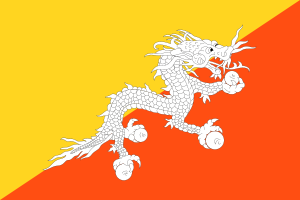

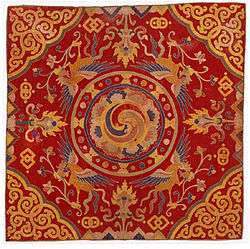

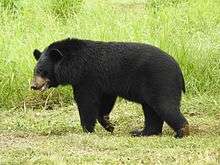

.jpg)
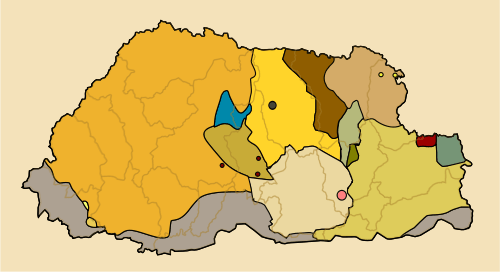

.svg.png)